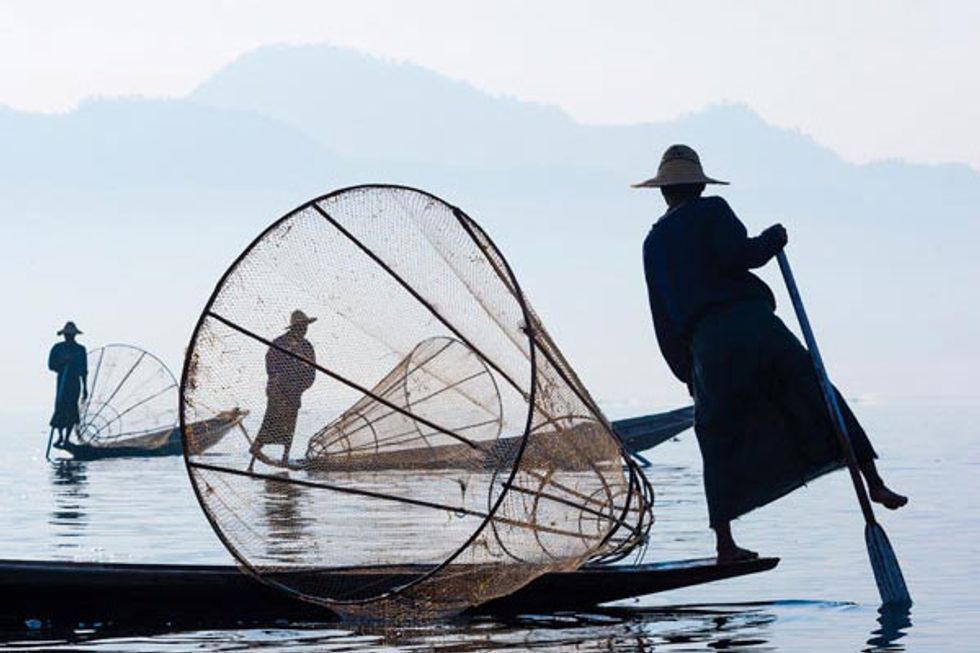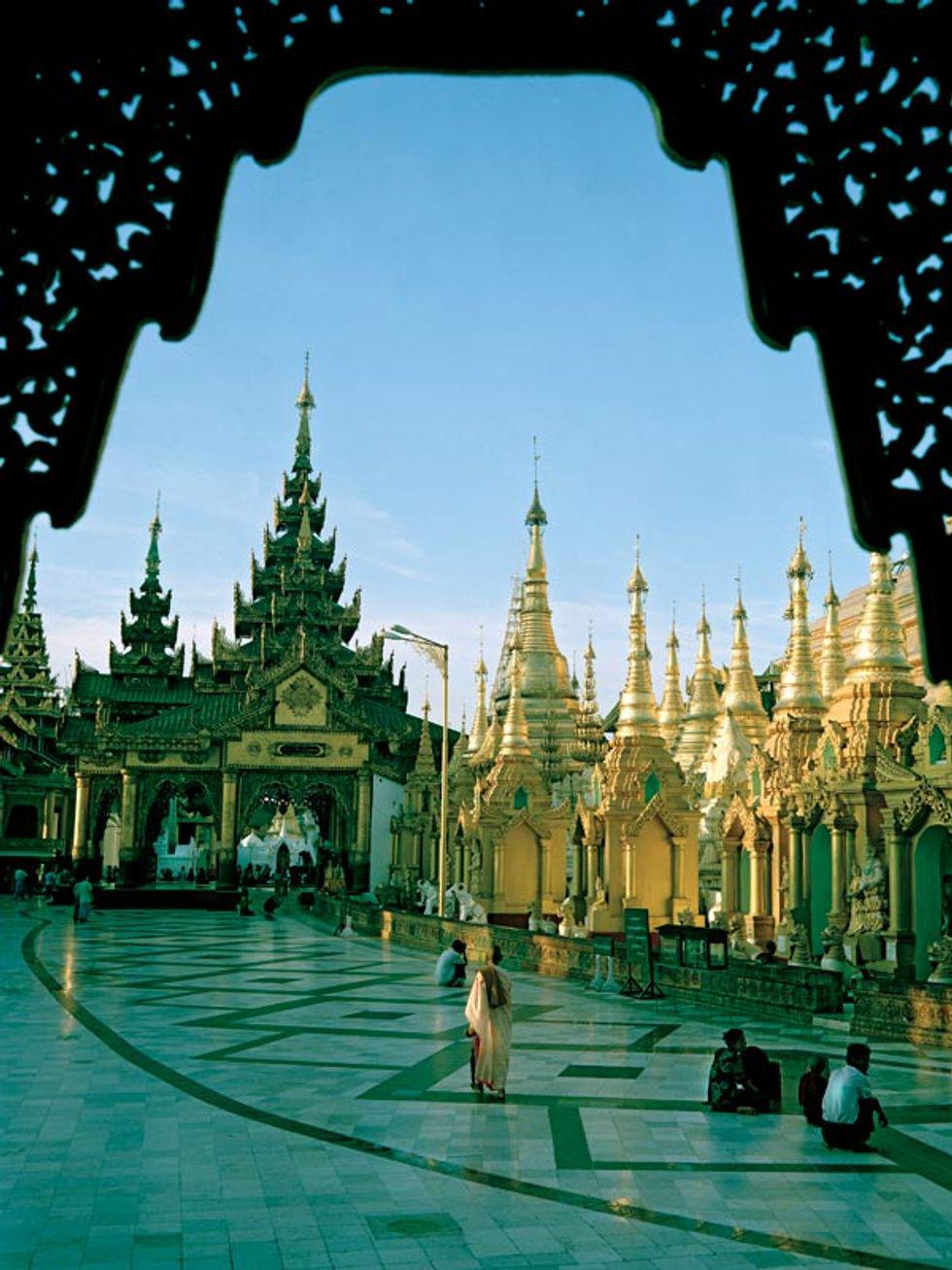A young man wearing a Britney Spears T-shirt tucked into a red longyi (wraparound skirt) poked at a tree with a 20-foot pole. I’d been in the dust of central Burma all day, traveling between ancient temples on a rickety bike, but this sight caught my interest.
“This owl—no good,” he explained in English. “It made my mom sick.”
I looked up to see a sad cluster of white feathers attached to a limp body in a crook of the tree. According to local belief, a loudly singing owl can be deadly, so the man, named Tun Tun, had to intervene. “I’ve seen one kill a little girl, so I shot this one with my catapult,” he said, referring to his slingshot. It is thought that the danger will pass only once the owl’s carcass is buried.
This was where a Rudyard Kipling quote rang true: “This is Burma…quite unlike any land you know about.”
Long-isolated Burma (or Myanmar) has suddenly found itself Southeast Asia’s hot destination. Yangon’s hotels have quadrupled their rates as demand exceeds beds, and foreign businesses—which once refused to mix with the country’s military junta—are pouring in. Return visitors notice more locals using cellphones and cars—even sporting blue jeans at rock shows sponsored by imported noodle manufacturers.
Travelers sometimes long for time-warp destinations, even at the expense of local progress. “The world talks of globalization,” says a Sittwe local. “But we don’t even have electricity. This is like the 15th century.” Burma is changing, but I don’t see the things that make it special going anywhere soon.
I am in Bagan, an archaeological zone on a wide bend of the Irrawaddy River, that is sometimes called Burma’s Angkor Wat. This historic spot is one of the country’s most popular destinations. Ancient kings built 4,000 temples in Bagan—before leaving the city to invading Mongols in 1287. The imaginative visitor could spend days exploring red brick paya (pagodas or stupas) with a flashlight. He or she would find hidden stairways, dotted with bat guano, that lead up to thrilling perches. The views from there are best seen at sunset.
The day after meeting Tun Tun, I pedaled to New Bagan, a village built virtually overnight in 1990, when the government relocated locals living on the site. There were a couple of streets with simple guesthouses, restaurants, and lacquerware shops. At one, a young woman, with circles of thanaka (bark paste) on her cheeks, rolled her eyes when I asked about the owl killer. “Some people still believe in those traditions. I don’t,” she said. A moment later, she admitted to leaving an offering of bananas and coconuts at the gate of a former palace after wrecking a new motorbike. “I’ve not had an accident since,” she boasted.
She was talking about making offerings to nats, or animist spirits. The national belief in them predates Buddha, and many Burmese still believe these spirits coexist with them. In many shops and homes, a visitor can see hanging coconuts dressed in ribbons and flowers, an offering for the nat house guardian, or ein saung.
Like the young woman who wrecked her motorbike, some Burmese downplay these things, at least some of the time. A 75-year-old auntie at a small guesthouse in nearby Nyaung-U explained why she prayed for her sick son 18 times a day. “Because 50 is too much; so is 30 or 40. But 18 is right,” she said. I asked if choosing that number had anything to do with the fact that 18 is a doubled 9, which is considered an auspicious number. Smiling, she agreed, “Ah yes, it is a good number, too.”
The sense of mysticism here is infectious. Wondering how it affected other nonnatives, I met up with four British expatriates who run Balloons over Bagan, a high-end tour company offering bird’s-eye views of the landscape. I found them less than cynical. One told me of an encounter with a ghost; for weeks afterward, he couldn’t sleep unless his generator-fueled light was on. They all recounted stories of having their palms read by a spot-on astrologer. The palm reader cautioned one of the expats not to drive after dark in June. He ignored the advice and had a wreck at 1 a.m. on June 2. “This country has a way of getting under your skin,” he said, reflecting on the prophecy.
On my last day in Bagan, I biked back to the owl hunter to see how his mother was doing. Tun Tun called me “brother” as he greeted me, and pointed to his mother, seated in the back of their tea shop, who returned my wave with a smile. He told me three more owls were in the tree. “But they don’t sing, so they’re OK,” he said. I didn’t mention the dead owl, but he adds, “These are our beliefs and traditions. The nats, Buddha—I believe them.”
I suspect he always will.
Ready. Steady. Go!
The greatest archeological site of Myanmar, Bagan is more than just “the Angkor Wat of Burma,” as some have dubbed it. The site of the first Burmese empire, Bagan is a wonder to visit, a riverside plain the size of Manhattan with over 4,000 temples that date nearly 1,000 years. Visitors see them via car, horse cart, bike or electronic motorbikes, stopping at busy stupas with high-up decks for sunset views, or lesser-seen squat temples decked in Hindu elements and filled with fading murals from distant kings’ reigns. Stop a bit in the shade on the dirt roads, and goat herders will invariably pass by, going from village to village. If you keep exploring, you’ll find plenty of room for yourself. At least for now. Tourist numbers totaled only half a million people in 2012 but are expected to reach 5 million by 2015.
Get there: Fly to Yangon International Airport
When to go: November - February
Who it's for: Anthropology Geeks, Archaeology Buffs, The Culturally Curious
Stay at The Hotel at Tharabar Gate: A well-designed boutique hotel inside millennium-old temple grounds? We’re there! Within walking distance of a handful of area highlights, this property sports a pool, a spa, and air-conditioned rooms.
Eat at Nanda Restaurant & Puppet Show: Sure, this is a touristy place, but the skill of the master puppetry is worth a look up from your rice. (Found in Wet-Kyi-Inn Village between Old Bagan and Nyaung U)
Soar in a Hot Air Balloon: Bagan’s consistently sunny days rival Turkey’s Turkey’s Cappadocia for world’s greatest ballooning destination. Starting from $320, you get picked up from your hotel, a champagne breakfast, and your journey floating over the thousands of ancient temples. Go with Balloons over Bagan.
Shop for Lacquerware: Myinkabar village, near Old Bagan, is famous for its handmade lacquerware. No one shop is better than another. They’re family run establishments that have been in operation for generations.
This article was published in 7x7's May 2014 issue. Click here to subscribe.

































